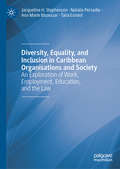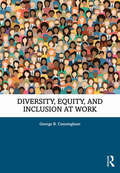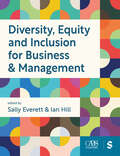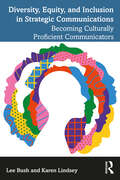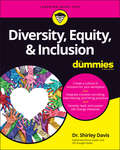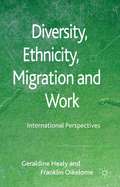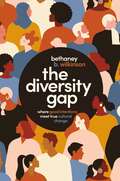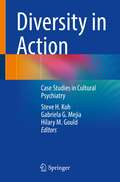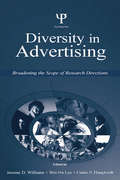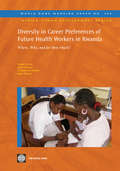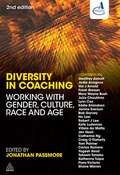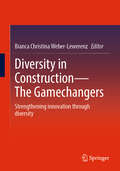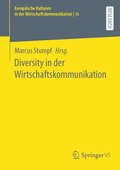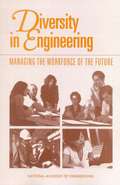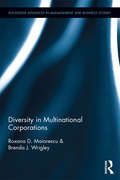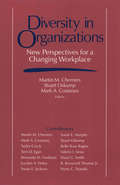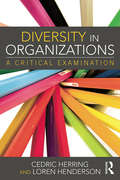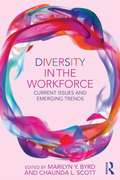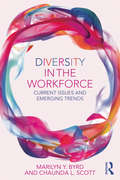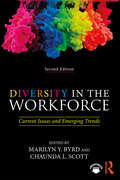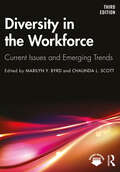- Table View
- List View
Diversity, Equality, and Inclusion in Caribbean Organisations and Society: An Exploration of Work, Employment, Education, and the Law
by Jacqueline H. Stephenson Natalie Persadie Ann Marie Bissessar Talia EsnardThis book focuses on equality, inclusion, and discrimination within the English-speaking Caribbean region, specifically as it relates to employment, education, society, and the law. Though anti-discrimination laws have recently been enacted in the Caribbean, this, in and of itself, neither translates to societal changes nor changes within the organisational context. The authors examine racial diversity in public sector organisations in Trinidad and Tobago and Guyana, gender diversity in organisations across the Caribbean region, sexual orientation and its impact on employment, disability and access within organisations, and equality and inclusion within Caribbean institutions of higher education. Further, the book explores the region’s equality laws and compares them with legislation from selected developed countries. This interdisciplinary text provides researchers in HRM, organisational behavior, sociology, and public policy with an overview of the types of discrimination prevalent within the Caribbean as well as the varied institutional frameworks in place that encourage equality.
Diversity, Equity, and Inclusion at Work
by George B. CunninghamDiversity, Equity, and Inclusion at Work is a comprehensive, accessible text focusing on DEI and how they influence employees’ access to work, their experiences in the workplace, and the outcomes for teams and organizations. The book examines the differences in opportunities and experiences among different groups as well as the ways managers can create more diverse, equitable, and inclusive workplaces. The book takes a multilevel approach and breaks down the issues to consider the micro-, meso-, and macro-level factors of DEI. The book is structured around three parts. The first section offers an overview of the foundations of DEI, including an overview and its relevance for aspiring managers, theoretical tenets of diversity, research in the area, and the constructs of bias. In the second section, the author examines the various forms of diversity, including race, gender, age, disability, appearance, sexual orientation and gender identity, religion, and social class. The final part supports the reader in thinking through strategies for reducing bias, creating diverse and inclusive workplaces, and ways organizations can impact the DEI in their communities. Pedagogical features include the following: ■ DEI at Work cases to open each chapter ■ DEI in Practice to connect theory to real-life examples■ Different Point of View boxes to present alternative perspectives■ Expert Perspectives to hear from professionals in the field■ Further reading and web resources to take extended learning opportunities■ Review questions to test knowledge
Diversity, Equity and Inclusion for Business & Management
by Ian Hill Sally EverettDiversity, Equity and Inclusion for Business & Management is a comprehensive and accessible guide to the evolving landscape of DEI in the discipline. Developed in collaboration with the Chartered Association of Business Schools and written by experts in their fields, this book offers a unique approach, with discipline-focussed chapters that cover Strategy, Leadership, Organisational Behaviour, Marketing, Accounting, Finance and more. As you read about how issues of social justice, diversity, and inclusion relate to your studies and future careers, you will be supported by a range of learning features, including global case studies, critical reflections, and practice questions. This book is essential reading for students of business and management taking modules in DEI and diversity management, as well as those who are interested in responsible business practice. Sally Everett is Professor of Business Education and Vice Dean (Education) at King’s Business School, King’s College London Ian Hill is a Lecturer in Work and Organisations (Education) at King’s Business School, King’s College London
Diversity, Equity and Inclusion for Business & Management
by Ian Hill Sally EverettDiversity, Equity and Inclusion for Business & Management is a comprehensive and accessible guide to the evolving landscape of DEI in the discipline. Developed in collaboration with the Chartered Association of Business Schools and written by experts in their fields, this book offers a unique approach, with discipline-focussed chapters that cover Strategy, Leadership, Organisational Behaviour, Marketing, Accounting, Finance and more. As you read about how issues of social justice, diversity, and inclusion relate to your studies and future careers, you will be supported by a range of learning features, including global case studies, critical reflections, and practice questions. This book is essential reading for students of business and management taking modules in DEI and diversity management, as well as those who are interested in responsible business practice. Sally Everett is Professor of Business Education and Vice Dean (Education) at King’s Business School, King’s College London Ian Hill is a Lecturer in Work and Organisations (Education) at King’s Business School, King’s College London
Diversity, Equity, and Inclusion in Strategic Communications: Becoming Culturally Proficient Communicators
by Karen Lindsey Lee BushTaking a DEI-first approach, this book teaches students to become culturally proficient communicators by approaching diversity, equity, and inclusion (DEI) with intentionality in every aspect of strategic communications. Those who work in strategic communications play a powerful role in shaping public perceptions and thus have a crucial responsibility to understand and practice the principles of diversity, equity, and inclusion in their work. This book introduces students to DEI theories and concepts and guides them through applying these concepts to communications research, planning, and execution. Chapters in the book align with the courses and competencies most often taught in advertising and public relations programs. It also includes chapters on “Inclusive Leadership” and “Working on Diverse Teams,” as students will need these competencies when working on group class projects and in preparing for internships. The concluding chapter on “Communicating for Social Change” allows students to look beyond advertising and PR as corporate-centered disciplines and expand their understanding of the power of communications to advocate for social justice and change. Ideal for students at the undergraduate level with relevance to graduate students as well, the book can be used as a stand-alone text in DEI communications courses, as a supplement to core advertising or public relations texts, or in modules in advanced communications courses. Online materials for instructors include teaching tips, suggested discussions and activities, student assignments, sample quizzes, and video links. They are available at www.routledge.com/9781032533865.
Diversity, Equity & Inclusion For Dummies
by Dr. Shirley DavisStrengthen your company culture through inclusive and equitable policies and practices The global workforce and marketplace will continue to undergo dramatic demographic shifts—redefining the workplace, the workers, and how work gets done. Organizations that want to attract and retain the best talent and to capitalize on the full breath of their perspectives and experiences must first reflect our society as a whole, and secondly, must create the right kind of work environment where ALL talent can thrive. That means valuing diversity, creating more equitable policies and practices, and fostering a welcoming and inclusive culture. In Diversity, Equity & Inclusion For Dummies, global workforce expert, and three-time Chief Diversity and Inclusion Officer Dr. Shirley Davis unveils her extensive collection of real-world experiences, stories, case studies, checklists, assessments, tips, and strategies that will give you a deeper understanding of the business impact of DEI and how your role as a leader can contribute to your company's long term success. You'll learn: The fundamentals of DEI and how it drives business performance and impact How to conduct comprehensive DEI organizational assessments to identify systemic and institutional inequities Tactics and strategies for having necessary but difficult conversations, and how to make them impactful Skills and competencies that every leader needs in order to effectively lead the new generation of workers How to operationalize DEI across your organization, measure its impact, and sustain it long term Diversity, Equity & Inclusion For Dummies is a must-read guide for any leader at any level who wants to ready themselves for the workplace of the future and reap the benefits of a full spectrum diverse ideas, backgrounds, and experiences. It also belongs on the reading lists of human resources and DEI professionals actively seeking to go broader, deeper, and have greater impact in their DEI work.
Diversity, Ethnicity, Migration and Work
by Geraldine Healy Franklin OikelomeThe contemporary relevance of Diversity, Ethnicity, Migration and Work is evident in debates on migration, racism and the global market in healthcare workers. It is about work and workers in the health care sector across three continents and in particular the UK, USA and Nigeria, focusing on highly qualified and skilled professional and low paid workers. This book is informed by current thinking on migration, ethnicity and work, including critical engagement with the literature on diasporas, social networks, social processes, anti-racism and feminism and diversity. The authors provide an historical and global perspective before engaging deeply with the working experience of highly qualified international migrants and low paid migrant and minority workers. They provide unique comparative and intersectional insights into the experience of migrant doctors compared to UK and US qualified doctors and deepen this understanding by an exploration of women doctors' experiences. The story of frontline low paid migrant and black and minority ethnic workers is told drawing on social process and the means of challenging inequalities through trade unions and social networks as well as diversity management strategies.
The Diversity Gap: Where Good Intentions Meet True Cultural Change
by Bethaney WilkinsonA sweeping leadership framework to institute clear and intentional actions throughout your organization so that people of all racial backgrounds are empowered to lead, collaborate, and excel at work.The Diversity Gap is a fearless, groundbreaking guide to help leaders at every level shatter the barriers that are causing diversity efforts to fail.Combining real-world research with honest first-person experiences, racial justice facilitator Bethaney Wilkinson provides leaders a replicable structure to foster a diverse culture of belonging within your organization.With illuminating and challenging insights on every page, you will:Better understand today&’s racial climate and its negative impact on your organization and team;Be equipped to shift your organizational culture from one that has good intentions for &“diversity&” to one that addresses systemic barriers to all employees thriving at work; andBe emboldened to participate in creating an organizational culture where people from various racial backgrounds are growing in their purpose, making their highest contributions, and collaborating effectively towards greater impact at work and in the world.Ultimately, The Diversity Gap is the quantum shift between well-intentioned organizational diversity programs that do little to move the needle and a lasting culture of equity and belonging that can transform your organization and outpace your industry.
Diversity Ideologies in Organizations: Diversity Ideologies In Organizations (Applied Psychology Series)
by Kecia M. Thomas Victoria C. Plaut Ny Mia TranSince the increased attention toward diversity in the workplace, the concepts of "diversity initiatives" and "diversity management" have become a common place in many conversations among academics and practitioners alike. The diversity movement in the workplace originated from the increased avocation for equal treatment of minority groups due to the dynamic composition of the modern workforce. Many organizations were forced to face these changes and the dilemma of how to respond to group differences to maintain and/or increase organization effectiveness and productivity. This volume will present new research on the colorblindness versus multiculturalism debate, assist in broadening the diversity ideology conversation, share this conversation across social science domains including industrial/organizational psychology, social psychology, and law and public policy, and highlight how the nature of diversity ideology may be fluid and therefore be different depending on the diversity dimension discussed.
Diversity in Accounting Principles: A Problem, a Strategic Imperative, or a Strategic Opportunity?
by William J. Bruns Jr.Provides an introduction to the diversity of generally accepted accounting principles. An example shows how financial reports in one firm could differ depending on accounting methods and principles selected. Presents arguments that this may be a problem, an imperative for change, or a strategic opportunity for managers.
Diversity in Action: Case Studies in Cultural Psychiatry
by Steve H. Koh Gabriela G. Mejia Hilary M. GouldThis book presents an extensive collection of high-yield case vignettes with recommendations for a comprehensive approach to cultural psychiatry. Culture is defined from an anthropological perspective, with an emphasis on aspects of culture beyond race, ethnicity, and other traditional demographic categories. The goal of this book is to offer clinical applications of cultural psychiatry via examination of special populations, systems, and settings. With ever-changing geopolitical environments, institutional structures, and sociodynamics, attention and consideration of context is paramount. Theoretical models and specific frameworks for evaluating cultural influence on the manifestation, development, and treatment response of mental health illnesses are presented. The chapters are organized to showcase different ways in which culture plays into everyday clinical practice. Emphasis is placed on the full sum of the care delivery transaction within a larger context, including public and community systems of care. Real-world case examples are discussed in each chapter to help contextualize the dynamic nature that culture plays in practice across inpatient and outpatient settings. Each case presents with relevant academic and historical background and practical operational advice for psychiatrists providing care within these respective communities. The authors address diverse clinical cases related to refugee and asylum seekers, military service members, survivors of human trafficking, incarcerated populations, and more. Training recommendations and best practices are outlined including psychopharmacology, psychosocial treatments, and cultural adaptations to evidence based treatments.Diversity in Action: Case Studies in Cultural Psychiatry is a useful resource for all psychiatrists, psychologists, general practitioners, social workers, nurses, administrators, public policy officials, and all medical professionals working with a culturally diverse subset of patients seeking mental health.
Diversity in Advertising: Broadening the Scope of Research Directions
by Jerome D. Williams Wei-Na Lee Curtis P. HaugtvedtThis volume grew out of the annual Advertising and Consumer Psychology conference sponsored by the Society for Consumer Psychology. Representing a collection of research from academics in the fields of social psychology, advertising, and marketing, the chapters all focus on discussing existing and needed research to face the challenges of diversity in the next millennium. The contributors are researchers who have pushed the envelope in understanding diversity in advertising, rather than merely relying on theoretical frameworks developed decades ago when the demographics of the population were much different. This volume provides a vast array of information for academics and practitioners seeking to better understand how individual characteristics impact on the sending, receiving, and processing of communication efforts. It highlights past and current knowledge on diversity in advertising, important questions that have not been addressed satisfactorily in this area, and how current theories can be used to construct better communication plans and message content. The various chapters draw upon existing literature from the fields of psychology, marketing, and related disciplines to amplify understanding and insight into developing effective advertising approaches to reach diverse audiences. This book will contribute to the understanding of the diversity of people, the changing landscape of the U.S., and the need for a more inclusive society.
Diversity in Career Preferences of Future Health Workers in Rwanda: Where, Why, and For How Much?
by Tomas Lievens Pieter Serneels Agnes Soucat Jean Damascene ButeraRelying on unique survey data, this paper analyzes the career preferences of future health workers in Rwanda, focusing on their sector preferences, their willingness to work in rural areas, their likelihood to migrate abroad, and their readiness to work in a high HIV prevalence environment. The findings show that health workers are not as uniform as is often thought, and can have very different preferences regarding wages, intrinsic motivation, and attitudes toward risk. But there are commonalities among future health workers, and the results highlight the importance of intrinsic motivation. To improve health policies, many governments have identified human resources in the health field as a policy priority. To improve policies, this paper provides evidence on health workers' choices and behavior, and it will be a valuable resource for government officials to design effective human resource policies. This working paper was produced as part of the World Bank's Africa Region Health Systems for Outcomes (HSO) Program. The Program, funded by the World Bank, the Government of Norway, the Government of the United Kingdom, and the Global Alliance for Vaccines and Immunization (GAVI), focuses on strengthening health systems in Africa to reach the poor and achieve tangible results related to Health, Nutrition, and Population. The main pillars and focus of the program center on knowledge and capacity building related to Human Resources for Health, Health Financing, Pharmaceuticals, Governance and Service Delivery, and Infrastructure and ICT.
Diversity in Coaching
by Jonathan Passmore Association for CoachingDiversity in Coaching explores the impact and implication of difference in coaching. The book looks at how coaches can respond to issues of gender, generational, cultural, national and racial difference. Understanding how diversity impacts upon coaching is a crucial element to coaching effectively in today's diverse society and can give coaches the edge when responding to their coachees need. Written by an international team of coaching professionals, the book provides guidance on understanding diversity and how coaches can adapt coaching styles and techniques to meet individual needs, local demands and cultural preferences.It explores the impact and implication of difference in coaching, providing practical information to help coaches respond effectively to issues of diversity.
Diversity in Construction – The Gamechangers: Strengthening innovation through diversity
by Bianca Christina Weber-LewerenzThe book explains why innovation and new digital technologies in the construction industry and beyond are largely dependent on a new culture of thinking. Personal experience reports from user practice and insights into research show the many human and technical potentials that have so far been insufficiently utilised. The book provides examples of how digital change can be shaped in a meaningful and constructive way. It looks back at the historical development of diversity in construction and highlights entrepreneurial paths towards a more diverse working culture, but also identifies the problem areas that hinder the innovation process. A variety of calls for action are derived from the inventory ‘Where do we stand?’ and the question ‘Where do we want (need) to go?’. Diversity is the key to success. This realisation is important in order to set the course for an innovative, sustainable construction industry now. The book identifies the key factors and core competences at all levels that are decisive for promoting diversity and innovation. If it utilises these consistently, the construction industry can take on a pioneering role at home and abroad.
Diversity in der Wirtschaftskommunikation (Europäische Kulturen in der Wirtschaftskommunikation #36)
by Marcus StumpfDiversity bedeutet Vielfalt oder Verschiedenheit. Bezogen auf sozialpolitische Felder bezieht Diversity sich zumeist auf den Schutz der Dimensionen geschlechtliche Identität, sexuelle Orientierung, Religion und Weltanschauung, ethnische Herkunft bzw. Nationalität, Alter sowie körperliche und geistige Verfassung. In Bezug auf diese Anwendungsfelder lässt sich ein konstanter Wandel in der Gesellschaft feststellen. Welche Konsequenzen diese Veränderungen auf die Wirtschaftskommunikation haben und wie Unternehmens- bzw. Marketingkommunikation mit Diversität umgehen, untersuchen die Autorinnen und Autoren dieses Bandes.
Diversity in Engineering: Managing the Workforce of the Future
by National Academy of Engineering Staff Diversity in the Engineering Workforce CommitteeThis report contains fifteen presentations from a workshop on best practices in managing diversity, hosted by the NAE Committee on Diversity in the Engineering Workforce on October 29-30, 2001. NAE (National Academy of Engineering) president William Wulf, IBM vice-president Nicholas Donofrio, and Ford vice-president James Padilla address the business case for diversity, and representatives of leading engineering employers discuss how to increase the recruitment, retention, and advancement of women and underrepresented minorities in engineering careers. Other speakers focus on mentoring, globalization, affirmative action backlash, and dealing with lawsuits. Corporate engineering and human resources managers attended the workshop and discussed diversity issues faced by corporations that employ engineers. Summaries of the discussions are also included in the report.
Diversity in Multinational Corporations (Routledge Advances in Management and Business Studies #67)
by Roxana Maiorescu Brenda WrigleyGlobalization, information and communication technologies, and the millennials who have entered the workforce, compelled corporations to change their resistant and defensive approaches to diversity and to proactively address differences. Companies determined that embracing diversity positively impacts their bottom line, as a result of the variety of perspectives and skills that derive from fostering a diverse workforce. To date, the majority of the studies in the business and communication fields shed light on diversity engagement in the US and leave room for the further exploration of how diversity is construed and approached in international milieus. There is a paucity of recent studies on diversity engagement in the US and the topic requires current investigation of the newest corporate engagement in diversity. Diversity in Multinational Corporations aims to address the two gaps in the literature. For this purpose, the book analyzes the diversity approaches of twenty-eight US companies from ten industries to develop a theoretical framework whose practical application enables companies to make significant contributions to the environments in which they operate. The framework addresses the present challenges that American corporations face in their diversity engagement, namely low employee engagement and "diversity fatigue," and proposes the implementation of a new social responsibility approach, whose aim is to address inequality at a global scale by adaption to the local environment and less focus on immediate business benefits. Finally, because the book discusses diversity engagement in global business environments, its results can be applied by international companies that operate at a global scale.
Diversity in Organizations: New Perspectives for a Changing Workplace
by Martin M Chemers Stuart Oskamp Mark ConstanzoThe changing demography of the workforce presents challenges and opportunities to individuals and to the organizations of which they are a part. This volume examines how diversity in organizations affords benefits such as a broader talent pool, but at the same time can lead to tension, misunderstanding and, at times, outright hostility.
Diversity in Organizations: A Critical Examination
by Cedric Herring Loren HendersonDiversity in Organizations argues that ensuring a diverse workforce composition has tangible benefits for organizations. Rather than relying on touchy-feely arguments, Herring and Henderson present compelling evidence that directly links diversity to the bottom line. Readers will learn: How and why diversity is related to business performance The impact of diversity training programs on productivity, business performance and promotions The biggest mistakes in diversity management, and how to avoid them What can be done to make diversity initiatives more effective and politically palatable How to measure success in diversity initiatives in rigorous, non-technical ways to achieve desired results Presented accessibly, without shying away from the contentious aspects of diversity, the book also provides concrete advice and guidance to those who seek to implement diversity programs and initiatives in their organizations, and to make their companies more competitive. Students taking classes in diversity, human resource management, sociology of work, and organizational psychology will find this a comprehensive, helpful resource.
Diversity in Sport Organizations
by George B. CunninghamWriting for undergraduate and graduate students, Cunningham (sport management, Texas A&M U.) discusses how diversity affects sports organizations, devoting attention to aspects of race, sex and gender, age, disability, obesity, religion, sexual orientation, and social class. Following an overview of diversity, approaches to its study, and an examination of prejudice and discrimination, he details compositional and relational types, and ways to manage workplace diversity. Both author and subject indexes are included. Annotation ©2007 Book News, Inc., Portland, OR (booknews.com)
Diversity in the Workforce: Current Issues and Emerging Trends
by Marilyn Y. Byrd Chaunda L. ScottDiversity in the Workforce is a comprehensive, integrated teaching resource providing students with the tools and methodologies they need to negotiate effectively the multicultural workplace, and to counter issues of discrimination and privilege.<p><p> Written from an American perspective, the book not only covers the traditional topics of race, gender, ethnicity and social class, but moves beyond this to explore emerging trends around ‘isms’ (racism, sexism), as well as transgender issues, spirituality, intergenerational workforce tensions, cross-cultural teams, physical appearance stigmatizing, visible and invisible disabilities, and racial harassment. The book:<p> Presents theoretical models to help students think critically about the issues that emerge from workforce diversity<p> •Includes a historical perspective that explains the roots of the issues in the workplace today<br> •Covers potential legal and ethical issues<br> •Introduces a social justice paradigm to encourage social action<br> •Illustrates strategies organizations are using to leverage diversity effectively <p>With end of chapter questions encouraging students to engage in difficult conversations, and case studies to stimulate students’ awareness of the real problems and issues that emerge from diversity, this book will help students develop the critical, analytical, problem solving and decision making skills they need to mediate or resolve diversity issues as future professionals.
Diversity in the Workforce: Current Issues and Emerging Trends
by Marilyn Y. Byrd Chaunda L. Scott<p>Diversity in the Workforce is a comprehensive, integrated teaching resource providing students with the tools and methodologies they need to negotiate effectively the multicultural workplace, and to counter issues of discrimination and privilege. <p>Written from an American perspective, the book not only covers the traditional topics of race, gender, ethnicity and social class, but moves beyond this to explore emerging trends around ‘isms’ (racism, sexism), as well as transgender issues, spirituality, intergenerational workforce tensions, cross-cultural teams, physical appearance stigmatizing, visible and invisible disabilities, and racial harassment. The book: <p> <li>Presents theoretical models to help students think critically about the issues that emerge from workforce diversity <li>Includes a historical perspective that explains the roots of the issues in the workplace today <li>Covers potential legal and ethical issues <li>Introduces a social justice paradigm to encourage social action <li>Illustrates strategies organizations are using to leverage diversity effectively <p> <p>With end of chapter questions encouraging students to engage in difficult conversations, and case studies to stimulate students’ awareness of the real problems and issues that emerge from diversity, this book will help students develop the critical, analytical, problem solving and decision making skills they need to mediate or resolve diversity issues as future professionals.</p>
Diversity in the Workforce: Current Issues and Emerging Trends
by Marilyn Y. Byrd Chaunda L. ScottThis comprehensive, integrated teaching resource provides students with the tools and methodologies they need to effectively negotiate the multiple dynamics that emerge from difference, and to appropriately respond to issues of marginalization and social injustice. Written from an American perspective, the book not only covers the traditional topics of race, gender, ethnicity, and social class, but explores emerging trends around “isms” (racism, sexism). This second edition includes two new chapters: one addressing social identity diversity and leadership in the workforce, and the other examining under-representation of diversity in the scientific, technical, and film workforce. This edition also features an updated chapter on social justice as an emerging diversity paradigm; this includes a conceptual framework to advance the ideology of organizational social justice. End-of-chapter questions encourage students to engage in difficult conversations, and case studies stimulate students’ awareness of real-world issues that emerge from diversity, helping students to develop the broad range of skills they need to mediate or resolve diversity issues as future professionals. Additional links, slides, multiple choice quizzes, and essay questions can be found online as a part of this book’s Instructor Resources.
Diversity in the Workforce: Current Issues and Emerging Trends
by Edited by Marilyn Y. Byrd and Chaunda L. ScottThis comprehensive, integrated teaching resource provides students with the tools and methodologies they need to effectively negotiate the multiple dynamics that emerge from difference, and to appropriately respond to issues of marginalization and social injustice. Written from an American perspective, the book not only covers the traditional topics of race, gender, ethnicity, and social class, but explores emerging trends around ‘-isms’ (racism, sexism). Thoroughly revised and updated, this third edition includes new case studies and expanded coverage of topics such as social justice, microaggressions, and gender identities and expressions. End-of-chapter questions encourage students to engage in difficult conversations, and case studies stimulate students’ awareness of real-world issues that emerge from diversity, helping students to develop the broad range of skills they need to mediate or resolve diversity issues as future professionals. This edition includes updated Instructor Resources such as PowerPoint slides, multiple choice quizzes, and essay questions as well as additional links which can be found online.
